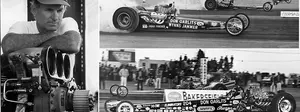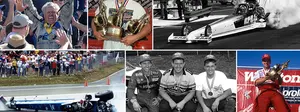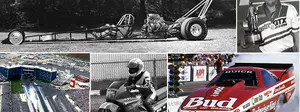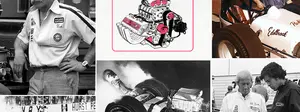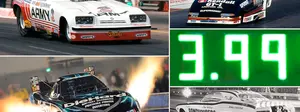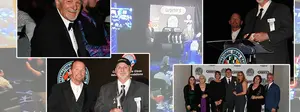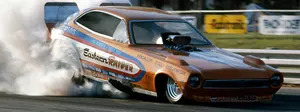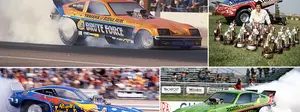

Gary Burgin, drag racing's 'Orange Baron'
 |
We lost Funny Car great Gary Burgin last Sunday, another passing of a fine racer who forever etched his name and his cars into our memory banks.
Burgin liked to brag that he had never driven anything down the dragstrip that didn’t have a blower on it, from his earliest days in the A/Gas Supercharged class through his great Funny Car career (and even the occasional Top Fuel ride). He was a prolific match racer and steady national event competitor, even if his final record showed just two NHRA national event Wallys on the shelf, which, as we’ve learned over time, is just one measure of a racer.
Yet despite his uncanny success on the match race trail, the guy whom we came to know as the “Orange Baron” – he lived in Southern California’s Orange County, but, as you'll read later, that wasn't how he got the name -- forever carved his place in the history and trivia books when he defeated Don Prudhomme in the final round of the 1976 U.S. Nationals, the guy who stopped the sport’s first perfect season dead in its tracks at the most high-profile event on the tour.
When he arrived in Indy, Prudhomme hadn't been beaten since the previous year’s U.S. Nationals, where he fell to Raymond Beadle. Already in 1976, he had won the Winternationals, Gatornationals, Springnationals, Summernationals, and Le Grandnational and didn’t seem to have a performance rival on the stage. Looking through past issues of National Dragster, though, it’s clear that Burgin had a killer car that year and dominated the East Coast match racing scene – far from home and, for whatever reason, seldom on the same track as “the Snake” -- with wins and track records that came in bunches. The smart followers knew what he was capable of, and he showed it that Labor Day weekend.
Burgin made a mind-boggling 12 runs during the Nationals (remember, this was before scheduled qualifying sessions), which included consistent qualifying shots of 6.16, 6.14, and finally a best of 6.12. Prudhomme still looked unbeatable with a national record blast of 5.97 in qualifying and subsequent runs of 6.03, 6.05, and 6.13 before eliminations. Come race day, Prudhomme ran 6.05, 6.13, and 6.15 prior to the final; by comparison, Burgin had run 6.12 and a pair of 6.21s. Advantage, “Snake,” no? No.
 |
Burgin had showed his chops in round two, where he set top speed of the meet at 238.09 mph – the second-fastest speed in class history behind the 241-mph blast by Prudhomme at the 1975 World Finals -- and, after beating 1975 Indy champ Beadle in the semifinals, Burgin took down “the Snake” in the final. Prudhomme’s Army Monza shook violently and smoked the tires to a losing 6.46, 226.70 while Burgin ran 6.25 at an impressive 237.46 mph.

 |
Burgin began his racing career in 1963, helping Dave Braskett campaign an A/GS Willys. After Braskett crashed the car at Irwindale Raceway in 1966, Burgin took over the driver’s seat and later got his own A/GS roadster, also supercharged. “I wanted to go fast right away, so I never messed around with carburetors or fuel injection,” he said.
 |
By the end of the 1960s, it was clear that Funny Cars were the next big thing, and he reunited with Braskett on first a Camaro and then a Vega that not only became a fixture on the Southern California scene, but also set the national record at 6.72 at Lions Drag Strip’s 1972 Grand Premiere (a race that ended with him upside down on the guardrail after a collision with fellow competitor Joe Winter).
After Braskett retired following the 1972 campaign, Burgin switched briefly to Top Fuel and drove Jim Thomas’ Genuine Suspension entry in 1973, then went back to the flops in 1974 behind the wheel of Jim Glenn’s Shady Glenn Dodge Charger, with which he won the Division 7 championship.
 |
After finishing eighth in the 1974 points standings, Burgin went out on his own in 1975 with his new Jaime Sarte-built Mustang and finished a career-high second in the standings behind Prudhomme in 1975, but due to his extensive match race schedule in 1976 (65 dates prior to Indy), even his Indy win couldn’t carry him into the top 10 again. Burgin would, however, finish in the top 10 three more times (eighth in 1977, fifth in 1981, and seventh in 1982). The 1979 season marked the debut of a new Sarte-built Mustang that carried him to his second victory, at the Springnationals, where he stopped world champ Beadle in the final. He almost won the Big Go again, in 1982, but lost in the final round to Billy Meyer.
 |
Even though he was still winning and doing well on the match race scene – and even landed a small sponsorship deal that 1979 season with Pete Rose’s new Supercharg’r Bar energy bar -- the bookings were beginning to dry up.
“When the match races were at their peak during the mid-1970s, a lot of tracks could book four to five nitro shows a year,” Burgin told National Dragster in 2013. “But as our expenses went up, so did the appearance fees, and eventually, the dragstrips backed down to two or three nitro match races a year. So I went from about 70 bookings a season down to 40 or less, which wasn’t enough to cover my expenses. And because I wasn’t like Billy Meyer when it came to obtaining corporate sponsors, I had no choice but to pull the plug with my own race car operations in 1983.”
Burgin was more than a great driver; he was a cerebral racer, too, capable of driving and tuning and knowing how the pieces interlocked. A few weeks ago, Prudhomme himself paid Burgin a huge compliment during an interview we were doing, saying, “He was very, very good and a very bright guy. He was one of those guys who could not only drive but really understood the engine.”


Gary and Gerry Burgin, in an image posted on her Facebook page.
|
I spoke to his wife, Gerry, earlier this week to express our condolences and to get her thoughts about the man to whom she was married for nearly 45 years. She was there for his glory days of Funny Car racing, and although her ability to travel was limited due to their young twin daughters, Sara and Reina, she did fly to a lot of races, and she was there for her husband’s grand moment in Indy.
“He loved the racing and loved working on the cars, but he wasn’t really a people person; that was my job,” she said, and I could almost detect over the phone a small grin at the happy memory. “He was all business at the racetrack.
“There was a reporter who once interviewed him after a run, asking Gary to tell him what happened on the run. Gary, being a very technical guy, told him the technical things that happened, and the guy just kinda looked at him like, ‘Uh, and what does that mean?’ and Gary just said, ‘I’m done with this interview.’ He was never one who liked to be in the spotlight.
“He was a quiet man, and he was very smart. He wasn’t much of a reader unless it was an instruction manual, and then he’d read it cover to cover, and then it was in his head, and he just knew it.”
 |
Burgin’s mechanical brains didn’t come in college, where he actually majored in marketing, which returns us to my earlier tease about the origin of his “Orange Baron” nickname and the imaginative logo shown at right of a World War I-vintage triplane and pilot with a fluttering scarf. It’s another classic Dragster Insider moment that I live for, finding out those “stories behind the stories” that I live and breathe for.
“Gary tried and tried to get a big sponsor but never could,” Gerry told me, “and he actually created the ‘Orange Baron’ name when he was trying to get a sponsorship with an orange juice company. It didn’t have anything to do with where we lived. He came up with the logo and everything, and even though the deal never came through, he kept the logo on his letterhead ever since.”
Her memories of her husband’s big win in Indy are still fresh in her mind, and, again, the joy of them was clear in her voice as we spoke.
"Oh my gosh; that was the most exciting day,” she said. “I was so excited that I just climbed into the back of the truck to pick him up and was jumping up and down in the back of the truck. I got grease all over my feet from the [fifth-wheel hitch], but I didn’t mind.”
She was just happy that her husband had finally achieved one of his goals and was quick to remind me that he won again a few years later in Columbus.

After he stopped driving in 1983, Burgin went on to tune for the likes of Jody Smart, Al Segrini, and Tom McEwen during the next couple of years but found his real second calling when Swedish Top Fuel racer Pelle Lindelow asked him to build a couple of Hemi engines and fly overseas to help him compete in the FIA European Drag Racing Championship Series. The Europeans were impressed, and before long, Burgin was flying to Europe six or seven times a year to assist his growing list of clients.
Burgin eventually formed Gary Burgin Enterprises, which exported everything from complete engine packages to related car components to racers around the globe.
“We’re basically an international one-stop shop for anyone racing with supercharged drag racing engines,” he said in our 2013 interview. “We now have about 500 customers from all over the world.”
The expansion into the global market allowed others around the world to know what we already knew – that Gary Burgin was one helluva nitro racer. He’ll be missed.



























